|
Relating to The Earl E. Myers Story Chapter 23 — RB-47 Combat Crew Training Page 1 of 2 Pages |
||||||||||||
|
RB-47Es arrived at Forbes AFB on 24 June 1954. Aircraft Commanders of these aircraft were Major General David Wade and Captain Earl Myers. |
||||||||||||
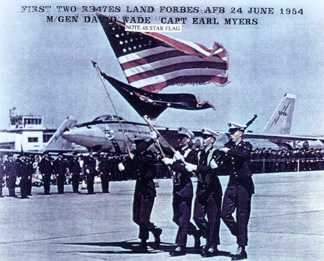 |
||||||||||||
| After the arrival of the first two RB-47s, the task of ferrying from Boeing Wichita to Forbes AFB, Kansas, began in earnest. There were 3 squadrons, the 319th, 320th and the 321st. Since the 320th had two RB-47 aircraft to start, they began operational flights at once. Training was the prime thing now to develop crew coordination, etc. After 5 flight's, I was designated as an instructor pilot. Capt Dick Newton was the copilot and Arch "Scotty" Scott was our radar navigator. |
||||||||||||
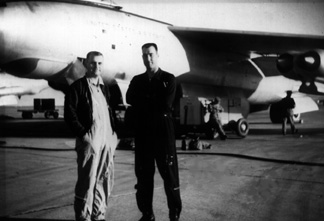 |
||||||||||||
| A special note re Dick Newton: When Dick Newton and I were crewed together, I did not realize that we would soon be parted. Newt was the most outstanding pilot and officer that I have ever been associated with. I was certainly shocked (though not surprised at their making this choice) when orders came through to transfer him to the Wing Standboard. |
||||||||||||
|
on the ramp at McConnell AFB. B-47 checkout aircraft in background. |
||||||||||||
| After attending McConnell AFB, B-47 Ground and Flight School, Newt, Scotty and I had accomplished about 5 training sorties flying out of Forbes. I would trade off with Newt in the front seat and he operated the RB-47 like he had taken all phases of primary, basic and advanced training in it and had been flying this aircraft all of his military career. His pilot skills were unbelievable. His integrity was never in question in any way. Newt also operated the same RB-29, "HONEY BUCKET HONCHO'S" during the Korean conflict, the same aircraft in which our crew completed 43 sorties — Good old #1929. Later, Newt was selected to be a B-52 Wing Commander. What responsibility. Superb, to say the least. Newt and his wife "Ruth now reside in St. Petersburg, Fl. It was certainly a coincidence that I asked him if he would scan his West Point Locator and let me know where Jack Romney lived, another "Pointer". His reply was, Vero Beach, Fl and gave the address. We had both lived in Vero Beach for several years and never had the pleasure of knowing that we were "neighbor's". Jack and his RB-29 crew took over and operated "HONEY BUCKET HONCHO" flying sorties in Korea. when our crew rotated, returning to the CONUS.
On the 3rd flight from Forbes we had a near miss with another 320th aircraft operated by Capt. Bob Lyells. We were over Peoria and both of us were at the assigned altitude and about a 60 degree's difference in heading. I think that we both saw each other at the same time as Bob pushed forward and I pulled up. We were about 200' apart and each at almost 600 mph. That made the rate of closure close to 1200 mph. God was with us both. "Our Father". The flight was continued and we both landed at Forbes after the 7 hour missions were completed. In October 1954, on a night Celestial training flight out of Forbes, our route of flight was over Big Bear Lake, North East of Salt Lake about 50 miles. All of a sudden a humongous bright flash was observed in the sky way to the West of Salt Lake. This was also before the extensive radar coverage by the FAA. We called Salt Lake and they responded that there was refueling in the area of Wendover. They asked if we could fly to the general area and observe where this had happened and to pin point the specific location.. There was a KC 97 refueling a B-47, both out of March Air Force Base, Calif. We did divert to the general area and observed several fires on the ground undoubtedly an aircraft from the in-flight incident. We pinpointed the debris and notified the FAA. We had brief radio contact with the KC-97 and confirmed it was the burning B-47 wreckage we had observed. Search crews were sent out and they soon had located the crash site. We were diverted to March AFB, on direction's from SAC Director of Operations, where we gave a full accounting of what we had witnessed to the convened accident board. After we were released in about two days, we planned another Celestial training flight out of March AFB where we landed at oour home base, Forbes. May God have Mercy on all the crew members who were on board the crashed B-47. Life moved on. Each squadron started receiving aircraft and it was not long before all 36 aircraft were in place and full scale operational flights began. It was around the clock scheduling for the 3 Squadrons. The ground crews had their hands full with a new aircraft as did the flight crews. In May of 1955, the 55th Recon Wing deployed to Morocco and the 90th was sent TDY at Eilsen AFB, Alaska. Both wings then had a full complement of aircraft. The TDY was necessary due to planned runway expansion and ramp improvements at Forbes. It seems like the cart was in place before the horse. |
||||||||||||
| We accomplished operational flights from Eilsen on a daily basis. Prior to departing Forbes, I had a new copilot assigned, Capt. (name withheld). He showed up two days before deployment and all bent out of shape. He had on a soiled uniform with vomit that only a drunk could tolerate. I sent him home to shave, shower and to get a decent uniform on. I objected immensely to the my supervisors that our new copilot was transferred to the 320th Squadron from the 319th Squadron for conduct unbecoming an officer. |
||||||||||||
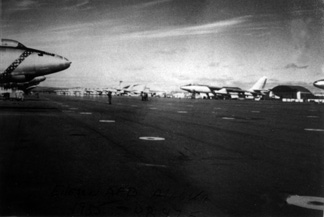 |
||||||||||||
|
Eilsen AFB with 90th Reconnaissance Wing |
||||||||||||
| He was an alcoholic for sure. I told my Squadron commander that I did not want him on the crew or even close to any aircraft that I was scheduled to fly. That proved to be of no avail. After making several initial flights with this new copilot, our crew was assigned a mission from Fairbanks over the pole with a turn over Newfoundland and continuation over Boston and Omaha, returning to Eilsen. On climb out, the pressurization was failing. Then the auto pilot decides that it did not want to function properly. It was necessary for both pilots to be alert and to trade off for the manual flying to avoid excessive fatigue on this extended flight.
After about 3 hours into the mission, we were schedule for in-flight refueling with a tanker from Thule, Greenland. The copilot did not read the check list and was observed in the back seat through my rear view mirror that his control column was stowed and he was asleep. That is putting it mildly. I asked Scotty to go aft and check on him. Scotty found a gallon jug with vodka and ice by his side. |
||||||||||||
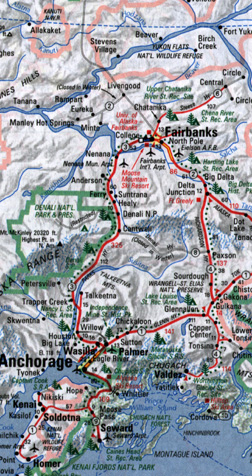 |
||||||||||||
| He was passed out colder than cold. Scotty went through the refueling check list and I assisted him in locating the required switches for the refueling. Scotty plugged into the oxygen system in the copilots position and did what was necessary for a successful refueling. On the return to Eilson we over flew Offutt AFB which was only about 130 miles North of Forbes. The entire flight of aircraft scheduled with us on our mission thought we would divert and land at Forbes. In spite of our difficulties, I chose to continue and we refueled 3 times all together. Scotty was proficient by then on the refueling panel, located in the back (copilots) seat. |
||||||||||||
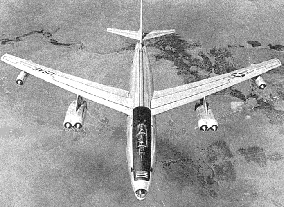 |
||||||||||||
| About over Big Delta VOR in Alaska, I contacted the control room and asked to have the Wing Commander, Wing Operations Officer, the Squadron Commander and the Operations Officer, plus the Air Police and a medic meet us on landing. The Control Room wanted to know why I wanted them present on landing. I refused to say "WHY" and I told them just to have them there. |
||||||||||||
|
|
||||||||||||
| After landing and engine shutdown, the main entrance hatch was opened, the Sq. Commander plugged in to the intercom from the ground and asked what the problem was. I asked him to take a look in the back seat at our copilot.
They had to lower him with the rope used for emergency escape. I got out of the aircraft first and was so bent over and cramped from the long extended flight, that I could barely function. I was also bent out of shape with our copilot. He was placed on a C-47 administrative flight that afternoon, with the destination of Forbes AFB, Kansas. He was gone from Forbes in less than 24 hours with no clear indication, to us, as to his disposition and future status in the USAF. While TDY at Eilsen AFB, Alaska, a lot of us became very friendly with the F-100 fighter sq. pilots. They later switched to F-86s. We had a most enjoyable time both on the ground and in flight. They would escort us outbound to a point where they had to return because of their fuel range. On return they would meet us and fly formation right down to the runway. With the 18' foot of flex in the wings when airborne it was really enjoyable to oscillate the ailerons back and forth. The full up/down movement aspect was astounding to the fighter jocks. It was like waving at them. On one return over BIG DELTA VOR and at the end of a profile mission, we were at FL 48,000'. The fighters did not observe us and questioned as to our location. Our reply was, “LOOK UP". When we put the drag gear down at that altitude, we plunged right through their formation and continued a decent to 20,000'. They pounced on us like an eagle does with a rabbit. We would visit their stag bar and all of us old bomber pilots learned several different bars of "Sammy Small" and many other fighter pilots renditions, like Itizuke Tower this is AF 801, etc. and etc. What a gang of pilots. This was an exclusive club for fighter pilots. They would do the same with us at the Officer's Club, but Sammy Small was presented in a different wording that was more acceptable in mixed company. |
||||||||||||
| On other weekends off we would go to the banks of the Tanana River and fish for Grayling and Trout, which ever was biting at that time. The water was clear and cold with lots of small rapids. One navigator by the name of Hugo Min, of Chinese decent, would go along and clean the fish and save the heads for fish soup. First though, he would suck the eyeballs out of their sockets. Another navigator named Jamie Ortiz Lopes was nicknamed "Three in One". He was a fisherman also. We could fish almost anytime our schedules permitted as the sun did not set while we were there. Later in the summer, the big trout go upstream to lay their egg's and you can literally wade out and catch them by hand. Harding Lake, to the south, was also a wonderful place to go and relax with good fishing as well. When the wind would blow hard, the big pines would sway back and forth in a threatening manner. Their root systems are not like what we are accustomed to in the lower 48. The roots only go a short distance into the ground because of the permafrost. The entire ground around the trees would move up and down and it was scary. |
||||||||||||
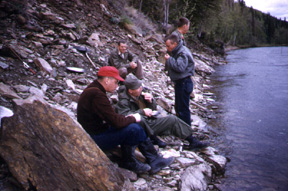 |
||||||||||||
|
Fishing on the Tanana River in August 1955. Below: |
||||||||||||
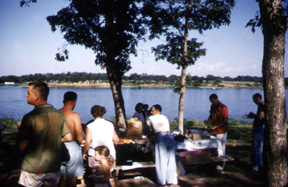 |
||||||||||||
| On local proficiency flights we would often fly up to Point Barrow on the North coast of the Arctic Ocean, about 300 miles North of Eilsen. We would descend to 1500' and fly across the city which had a few buildings and one heck of a lot of Igloos. The Eskimos would flock outside to watch us pass over, waving like mad. On return we would proceed to Nome on the Bering Sea, make a few high speed GCAs (Ground Controlled Approach), and then head back to home base.
Editor's Note: For those of you who would like to review some End of Page 1 of 2, Chapter 23 — Go to Page 2 Go to EEM Introduction —Chapter 1 — 2 — 3 — 4 — 5 — 6 — 7 — 8 |
||||||||||||